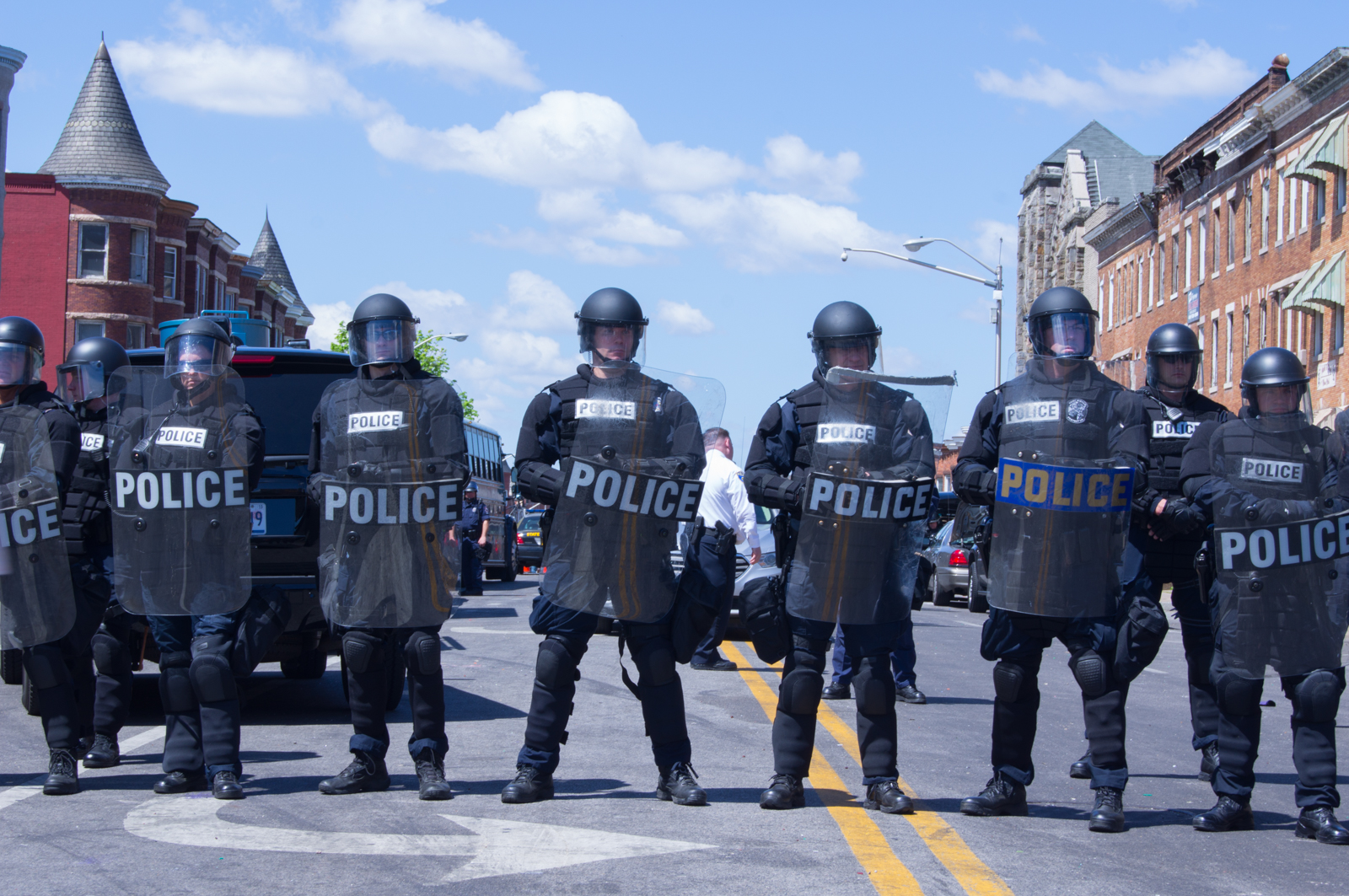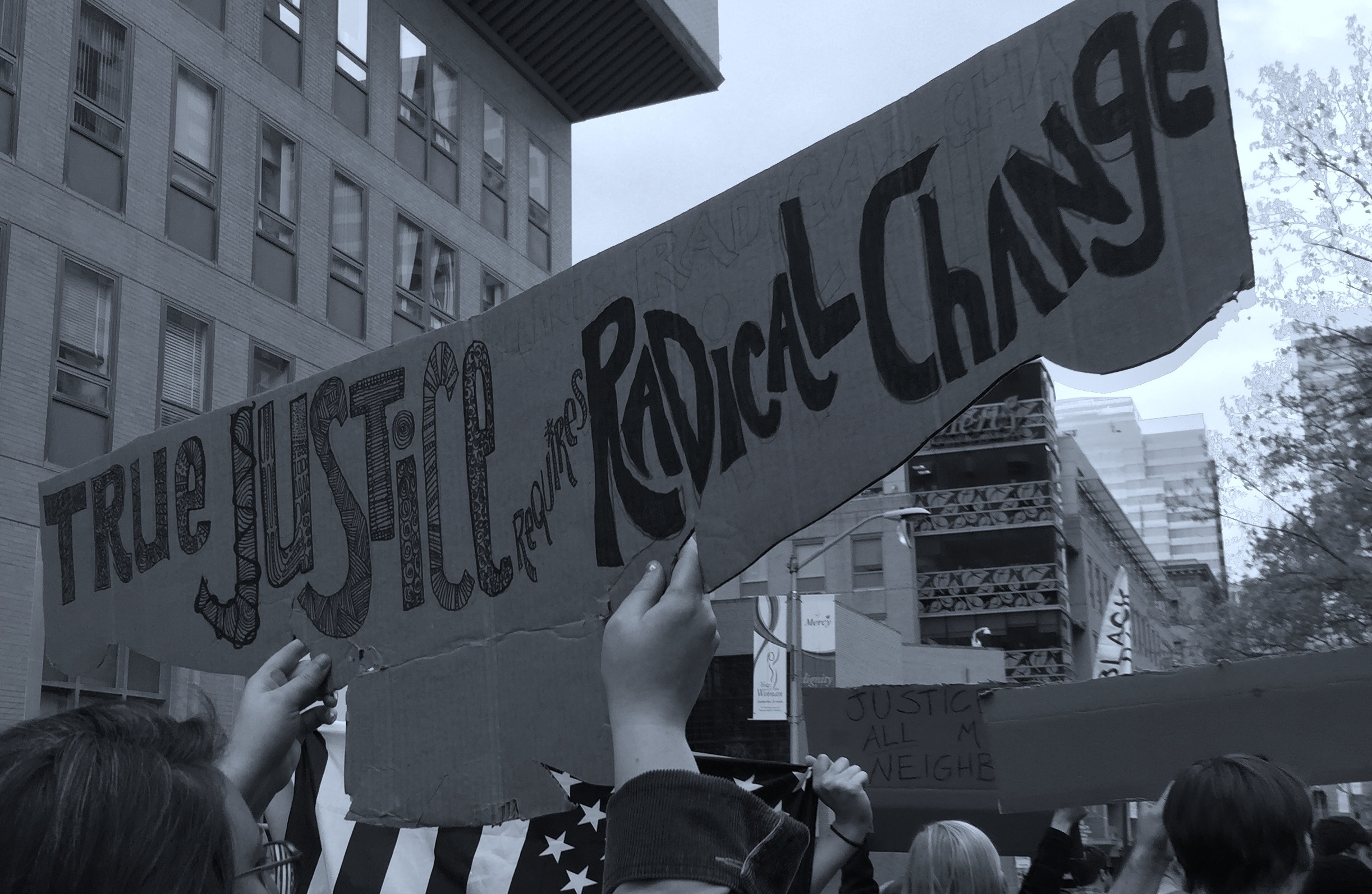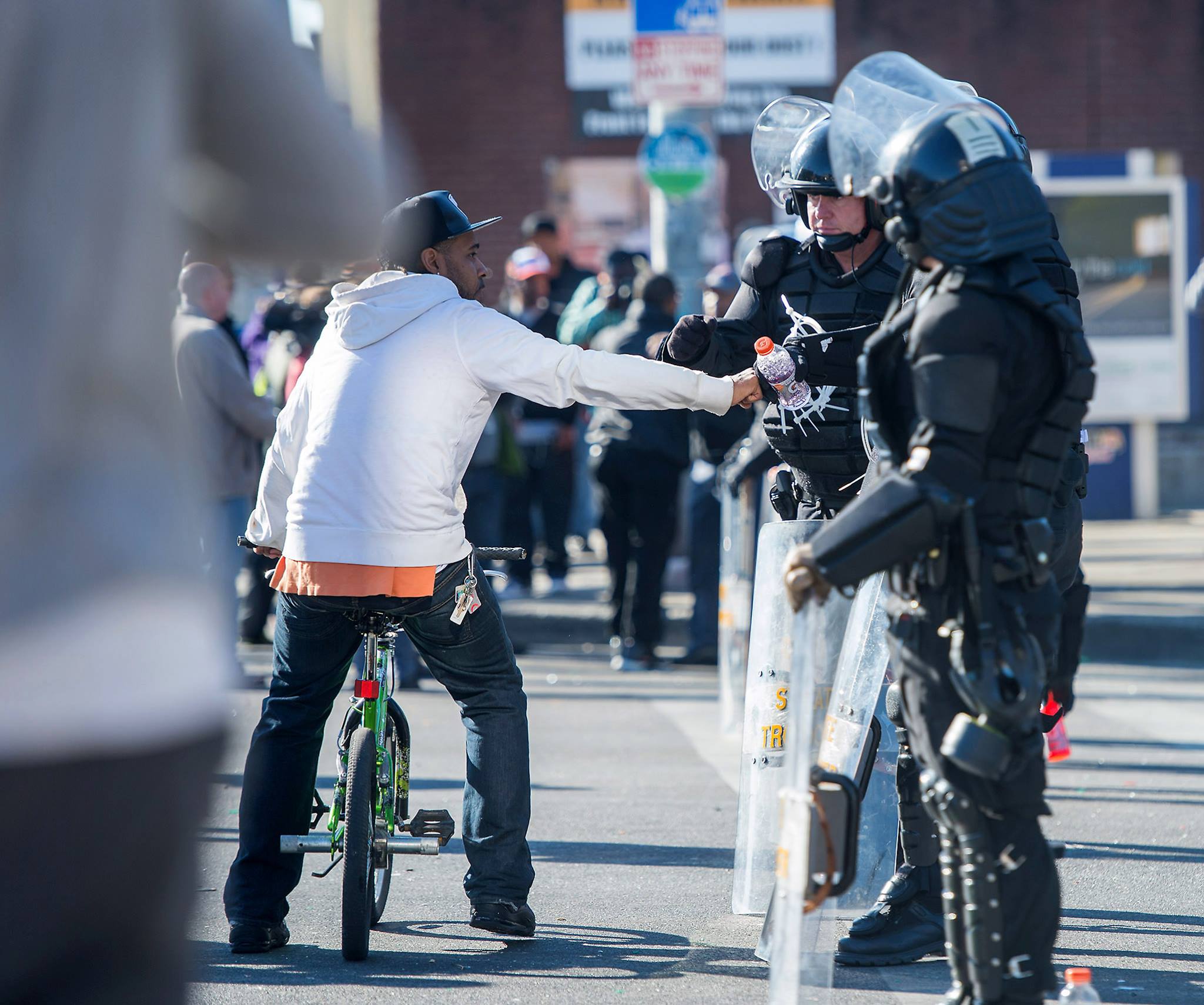As Michael Farley noted in a candid piece written earlier this week, the place of art criticism in a city wracked by protests and partitioned by phalanxes of armed vehicles can seem – well, negligible, or even wholly irrelevant. What can a sensitive meditation on, say, the handling of paint or the juxtaposition of materials in a recently hung piece matter, as hundreds of marchers chant and thrust their fists in the air?
“If you are neutral in situations of injustice,” read a sign held high by a protestor at City Hall on Wednesday evening, “you have chosen the side of the oppressor.” And if you spend your time strolling through Sérgio Sister’s work at Goya Gallery, or Sarah VanDerBeek’s sleek installation at the BMA? Well, the implication is clear.
And yet, over the past week I’ve also been struck by the centrality of images in the debates that have preoccupied much of Baltimore. Obviously, the protests have been primarily motivated by actual events and experiences: the death of Freddie Gray; a history of systematic police brutality; systematic racial and economic injustice. This is an uprising rooted in real concerns. But, still, those concerns are being enunciated and given a wide circulation through thousands of salient photographs, videos, and televised images. What’s being said, to be sure, is important. Boots on the street matter, and gestures can be powerful. But what’s being shown, and how, also matters.
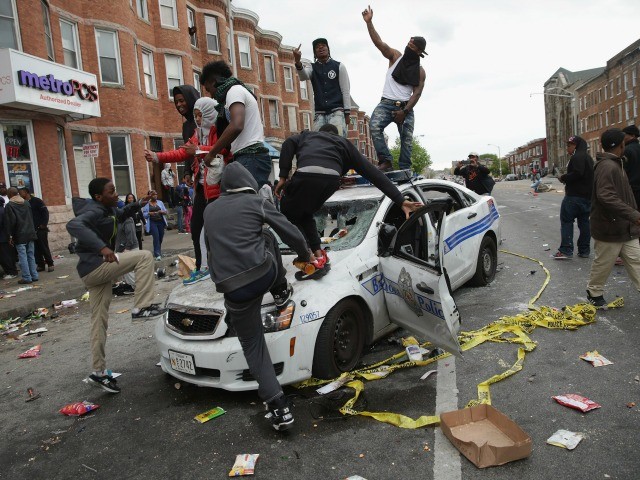
Take, for instance, a photograph published prominently on the website of the conservative Breitbart News Network on Tuesday, April 28. The photo, which was taken by Chip Somodevilla, ran atop a piece by Warner Todd Huston that mocked what he saw as media efforts to downplay or apologize for the previous night’s violence. Given the bent of the article, the choice the image was clearly calculated. The teens atop the police car, the smashed windshield, the middle finger gleefully raised high, the police barricade tape reduced to an ineffectual ribbon: each of the details worked to suggest a complete erosion of authority, undermining any claim that Monday’s violence was not merely wanton.
But if the photograph thus embodied the point of the article, it also worked on a subtler and more abstract level, as it quietly recalled a disturbing analogy – one which soon turned up in the comments section below the article. “They also, in their manner,” wrote a Wiggumc1, “don’t look much different than the apes in the new Planet of the Apes.” And so the picture did its dirty work, by slyly insinuating that the rioters were nothing more than animals. Indeed, you might even say that it thus completed a sinister pictorial loop. Look up the most popular online video of baboons on a car roof (which has already garnered more than 300,000 views), and you’ll find that the top comment asks, egregiously, “Is this the Obama family reunion?” Racist, essentializing currents travel without resistance along such a closed circuit.
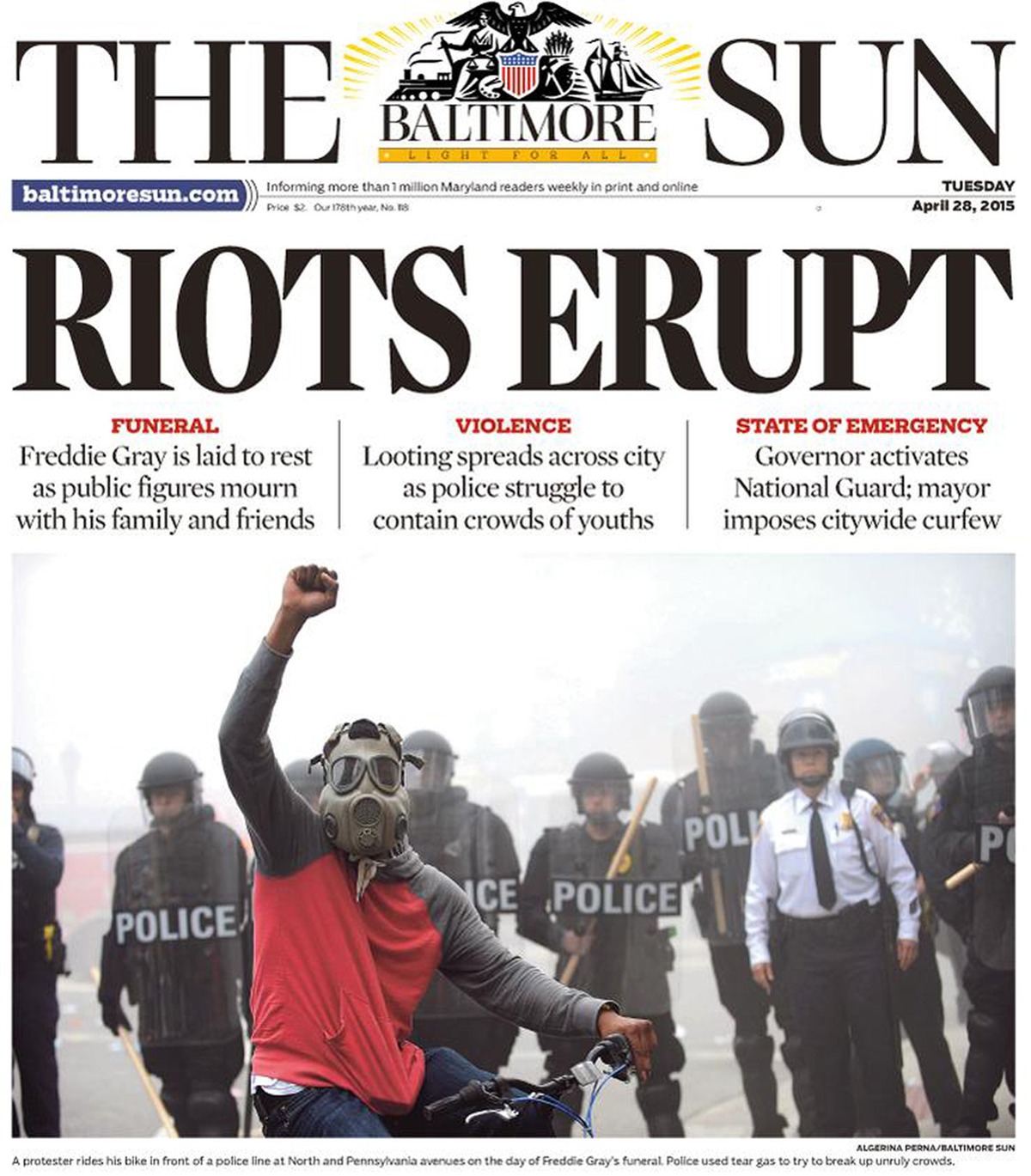
By contrast, the Sun featured a very different sort of photograph on that same morning. In an image shot by Algerina Perna, a black protestor wears a gas mask, turns his back on a phalanx of riot police – and raises one hand, in a clenched fist. Again, the photograph works in conjunction with the accompanying text: the headline emphasizes the violence that shook the city, and the figure’s clenched hand leads our eye directly toward the word looting. This is not a merely celebratory image. But it certainly offers a distinctive view of the rioters, who are now implicitly cast as individuals, raising fist (rather than finger) in the face of authority.
And that gesture matters, for it too evokes a larger, backing series of imageries. In 1943, Jean-Paul Sartre wrote (in Being and Nothingness) that “In itself a clenched fist is nothing and means nothing. But we never perceive a clenched fist. We perceive a man who in a certain situation clenches his fist.” Fair enough – and ever since Stokely Carmichael thrust his clenched fist into the air at a 1966 rally, that situation has commonly involved racial struggle, or protest. Consequently, the raised fist has become a basic motif in American visual culture, with a relatively stable set of associations: power, self-affirmation, subjectivity. Through his gesture, as a result, the rioter becomes an ennobled protagonist.
Clearly, then, two photographs can give a starkly different impression of a single evening’s events. Or, to put it slightly differently: while photographs may be motivated by real events, they give us particular – or, better, merely partial – views of reality. Consequently, much depends on which images we choose to emphasize. But our interpretations of those images also matter. As the theorist Roland Barthes once argued, photographs can be thought of as codes: they both denote and connote, and their connotations often depend, for effect, upon the identity of the viewer. Despite their apparent transparency, in other words, photographs are often read in the light of the viewer’s age, class, ethnicity, and political beliefs.
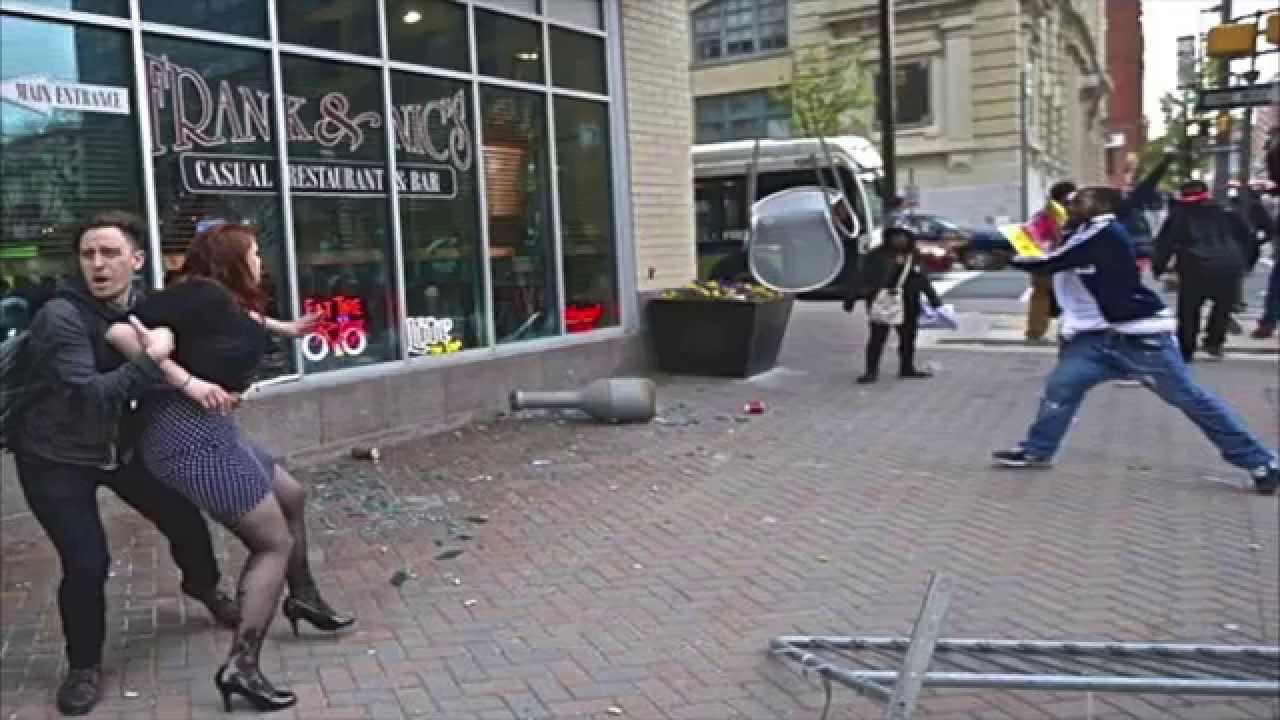
Indeed, that seems to be one of the lessons implicit in the reactions to the photograph pictured above. It depicts City Paper’s Brandon Soderberg, to the far left, stopping a woman from walking toward a protestor who is hurling a chair through a window near a bar on Saturday, April 25. As Soderberg wrote in a recent meditation on the image, the photograph appeared on BuzzFeed and quickly took on a life of its own – or, as he put it, “was quickly co-opted by those who like to present an all-too-common and easy narrative: white people being terrorized by black people.”
Co-opted? Well, from Soderberg’s view, the situation was rather less dramatic. After all, he didn’t know the woman, and was largely sympathetic toward the protestors: by his account, he was simply trying to help defuse a tense situation. But of course the photograph doesn’t convey his intentions very clearly at all. As a result, tweeted responses to the photograph varied considerably. Some lauded what they saw as his courage, some praised him for coming to the aid of a white woman, and still others used irony to mock the intelligence of the protestor (“‘I’ll just throw this chair through a sports bar,” read one reaction, “and social justice will be restored.”)
Clearly, then, photographs aren’t necessarily closed, or associated with a single meaning; rather, they are polysemic, or readable in various ways. And in a charged context, readings will often reflect the instinctive political sentiments of the readers. A classic example of this phenomenon occurred in the culture wars of the 1980s – when, Kobena Mercer noted, Robert Mapplethorpe’s coolly beautiful but emphatically homoerotic photographs sparked “a war of position in which the reading of visual images has itself become a preeminently political affair.” But, really, there’s no need to think art historically, for in fact a similar pattern was on display in Baltimore this week.
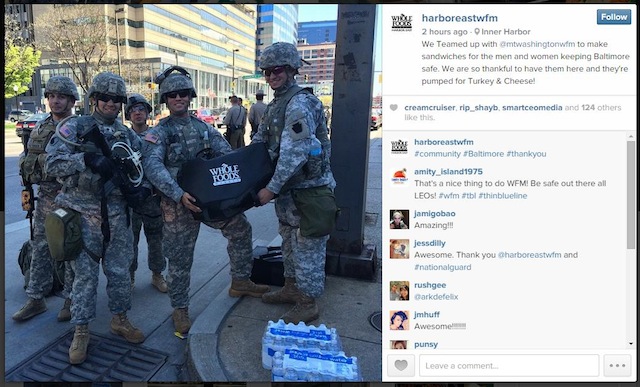
Consider the photograph of a group of National Guard soldiers that was posted by Whole Foods on its Facebook account on Tuesday. Whole Foods had just delivered a number of free lunches to the soldiers, and to some online readers, the post was merely evidence of a cordial gesture. To others, however, it was an alarmingly insensitive stunt: after all, Baltimore city schools were closed on that same day, meaning that some low-income students had little to eat.
“This is tone-deaf,” wrote Imani Gandy, “especially when thousands of school kids in Baltimore need lunch.” Certainly, most of the reactions concentrated on the event, rather than the picture. But the picture, of course, accompanied the announcement of the event – and surely the satisfied, healthy smiles of the armed soldiers and the slick centering of the Whole Foods logo only intensified public resentment by implying a happy marriage of corporate and military interests. Negative reactions multiplied quickly, and within three hours Whole Foods had deleted the post.

That episode was jarring – but, again, not unprecedented. Indeed, it was vaguely reminiscent of the fiery response to a 2011 Associated Press photograph that depicted the embattled Tunisian president Zine el-Abidine Ben Ali visiting the hospital room of Mohammed Bouazizi, the 26-year-old who had set himself on fire after having his vegetable cart confiscated by the police. Ben Ali apparently felt that the photograph cast him as compassionate and paternal, and sanctioned the official release of the image. But he was thus taken aback by the vigorous public condemnation that followed, as many criticized him crass opportunism, while others chastised him for not having visited Bouazizi earlier. The image, when circulated, was given an unintended meaning – and public protests against Ben Ali rapidly intensified, eventually forcing him from office a mere two weeks later.
To be sure, the photograph of Ben Ali was hardly the primary cause of the Jasmine Revolution; if anything, it was merely one among a number of catalysts. But the point is that, at least for a few weeks, the public’s attentive reading of a circulating image galvanized its opposition to the state. And that, it seems to me, is a form of art criticism; at least, it has been in the past. One of the most important art critics of the nineteenth century was Charles Baudelaire; a well-known poet, Baudelaire was also an activist, and took part in the working-class uprising of June 1848 and in demonstrations against the Bonapartist regime in 1851. And he saw his writing on art – on Delacroix, on Guys, and on the place of modern panting – as directly informed by his politics. “Criticism,” he famously wrote, “should be partial, impassioned, political.”
“Criticism,” he famously wrote, “should be partial, impassioned, political.”
Admittedly, Baudelaire wouldn’t have considered the photographs that have come out of a week of protests in Baltimore art. He was clear about this: in an 1859 essay called “On Photography,” he argued that the true duty of photography was to act not as a fine art, but rather as a servant of the arts and sciences – like, he wrote, printing. A century and a half later, however, our general notion of art has expanded, and we have little trouble accepting photography (or printing, for that matter) as an art. Indeed, as the heated responses to the images of unrest in Baltimore imply, the public is alert to the fact that photographs are not mere servants to larger causes. Rather, we seem to sense, photographs embody and articulate those causes in specific ways.
And so you might say that art criticism, if we interpret that term in a broad sense, is in fact entirely relevant in a time of protest. After all, the past week has prompted a groundswell of criticism, as thousands of viewers have offered their own reactions to the images that wash across their phone screens and televisions: reactions that have often been consistently partial, impassioned, and political. Sure, it’s not art criticism in the stereotypical, refined sense, and Farley is right: the critic silently mulling over a gallery show is bound to feel marginal in days like these. But art criticism has never been merely bound, in fact, to the gallery. Indeed, one of the earliest examples of art criticism is a pamphlet, written in 1741, that was distributed on the streets of Paris and that prefaced its consideration of the artworks in that year’s Salon with a scathing series of remarks about the privileged local aristocracy.
Art, and art criticism, can do only so much. Sometimes there is a need for something more: for loud protests, for systemic reform. But to claim that art criticism therefore has nothing to offer seems to me too simple, too narrow. In a sense, we are all critics when we work to understand the images of the past week’s events. And we are all performing a vital form of criticism as we consider, aloud or in print, what those images tell us about what has happened, and what is to come.
Author Kerr Houston teaches art history and art criticism at MICA; he is also the author of An Introduction to Art Criticism (Pearson, 2013) and recent essays on Wafaa Bilal, Emily Jacir, and Candice Breitz.
